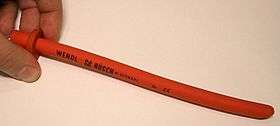Nasopharyngeal airway
| Nasopharyngeal airway | |
|---|---|
| Intervention | |
 Nasopharyngeal airway. | |
| ICD-9-CM | 96.01 |
In medicine, a nasopharyngeal airway, also known as an NPA, nasal trumpet (because of its flared end), or nose hose, a type of airway adjunct, is a tube that is designed to be inserted into the nasal passageway to secure an open airway. When a patient becomes unconscious, the muscles in the jaw commonly relax and can allow the tongue to slide back and obstruct the airway. This makes airway management necessary, and an NPA is one of the available tools. The purpose of the flared end is to prevent the device from becoming lost inside the patient's nose.
Sizes
As with other catheters, NPAs are measured using the French catheter scale, but sizes are usually also quoted in millimeters. Typical sizes include: 6.5 mm/28FR, 7.0 mm/30FR, 7.5 mm/32FR, 8.0 mm/34FR, and 8.5 mm/36FR
Indications and contraindications
These devices are used by emergency care professionals such as EMTs and paramedics in situations where an artificial form of airway maintenance is necessary, but tracheal intubation is impossible, inadvisable, or outside the practitioner's scope of practice. An NPA is often used in conscious patients where an oropharyngeal airway would trigger the gag reflex.
Nasopharyngeal airways are also used, though very rarely, by people who have severe sleep apnea, inserted by the patient themselves at home.
Insertion
The correct size airway is chosen by measuring the device on the patient: the device should reach from the patient's nostril to the earlobe or the angle of the jaw.[1] The outside of the tube is lubricated with a water-based lubricant so that it enters the nose more easily. The device is inserted until the flared end rests against the nostril. Some tubes contain a safety pin to prevent inserting the tube too deeply. Care must be taken to ensure the pin does not stick into the nostril. In the event that a pin is not available, you may also stop insertion just short of the natural gag reflex and tape the remaining exposed portion of the NPA to the surrounding facial tissue.
References
- ↑ Daniel Limmer and Michael F. O'Keefe. 2005. Emergency Care 10th ed. Edward T. Dickinson, Ed. Pearson, Prentice Hall. Upper Saddle River, New Jersey. Page 147.